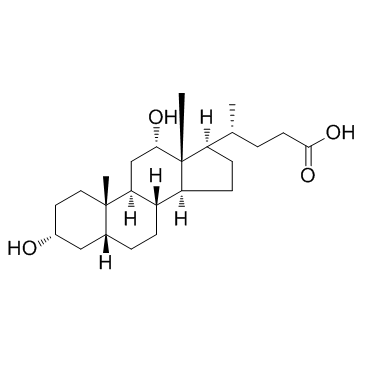Deoxycholic acid

Deoxycholic acid structure
|
Common Name | Deoxycholic acid | ||
|---|---|---|---|---|
| CAS Number | 83-44-3 | Molecular Weight | 392.572 | |
| Density | 1.1±0.1 g/cm3 | Boiling Point | 547.1±35.0 °C at 760 mmHg | |
| Molecular Formula | C24H40O4 | Melting Point | 171-174 °C(lit.) | |
| MSDS | Chinese USA | Flash Point | 298.8±22.4 °C | |
| Symbol |

GHS07 |
Signal Word | Warning | |
|
MicroRNA-99a and 100 mediated upregulation of FOXA1 in bladder cancer.
Oncotarget 5(15) , 6375-86, (2014) Urothelial cell carcinoma of the bladder (UCC) is a common disease often characterized by FGFR3 dysregulation. Whilst upregulation of this oncogene occurs most frequently in low-grade non-invasive tumors, recent data reveal increased FGFR3 expression characte... |
|
|
Involvement of epigenetics and EMT-related miRNA in arsenic-induced neoplastic transformation and their potential clinical use.
Cancer Prev. Res. (Phila.) 8(3) , 208-21, (2015) Exposure to toxicants leads to cumulative molecular changes that overtime increase a subject's risk of developing urothelial carcinoma. To assess the impact of arsenic exposure at a time progressive manner, we developed and characterized a cell culture model ... |
|
|
MicroRNA expression profiles associated with acquired gefitinib-resistance in human lung adenocarcinoma cells.
Mol. Med. Report. 11(1) , 333-40, (2014) The aim of the present study was to establish, characterize and elucidate the potential mechanisms of acquired gefitinb resistance, using the A549 human lung cancer cell line. A gefitinib-resistant A549 sub-clone was established by exposure to escalating gefi... |
|
|
Extracellular signal-regulated kinase1/2-dependent changes in tight junctions after ischemic preconditioning contributes to tolerance induction after ischemic stroke.
Brain Struct. Funct. 220(1) , 13-26, (2015) Less disruption of the blood-brain barrier (BBB) after severe ischemic stroke is one of the beneficial outcomes of ischemic preconditioning (IP). However, the effect of IP on tight junctions (TJs), which regulate paracellular permeability of the BBB, is not w... |
|
|
Involvement of the H1 Histamine Receptor, p38 MAP Kinase, Myosin Light Chains Kinase, and Rho/ROCK in Histamine-Induced Endothelial Barrier Dysfunction.
Microcirculation 22 , 237-48, (2015) The mechanisms by which histamine increases microvascular permeability remain poorly understood. We tested the hypothesis that H1 receptor activation disrupts the endothelial barrier and investigated potential downstream signals.We used confluent EC monolayer... |
|
|
DNA Methylation Changes Induced by a High-Fat Diet and Fish Oil Supplementation in the Skeletal Muscle of Mice.
J. Nutrigenet. Nutrigenomics 7 , 314-26, (2015) To investigate the global changes in DNA methylation and methylation of the promoter region of the peroxisome proliferator-activated receptor gamma transcript variant 2 (Pparg2) gene resulting from a high-fat diet (HFD) and/or fish oil supplementation.Fish oi... |
|
|
Macrophage and epithelial cell H-ferritin expression regulates renal inflammation.
Kidney Int. 88 , 95-108, (2015) Inflammation culminating in fibrosis contributes to progressive kidney disease. Cross-talk between the tubular epithelium and interstitial cells regulates inflammation by a coordinated release of cytokines and chemokines. Here we studied the role of heme oxyg... |
|
|
Loss of MT1-MMP causes cell senescence and nuclear defects which can be reversed by retinoic acid.
EMBO J. 34 , 1875-88, (2015) MT1-MMP (MMP14) is a collagenolytic enzyme located at the cell surface and implicated in extracellular matrix (ECM) remodeling. Mmp14(-/-) mice present dwarfism, bone abnormalities, and premature death. We demonstrate herein that the loss of MT1-MMP also caus... |
|
|
Identification of proteins associated with Aha1 in HeLa cells by quantitative proteomics.
Biochim. Biophys. Acta 1854(5) , 365-80, (2015) The identification of the activator of heat shock protein 90 (Hsp90) ATPase's (Aha1) protein-protein interaction (PPI) network will provide critical insights into the relationship of Aha1 with multi-molecular complexes and shed light onto Aha1's interconnecti... |
|
|
The NADPH oxidase NOX5 protects against apoptosis in ALK-positive anaplastic large-cell lymphoma cell lines.
Free Radic. Biol. Med. 84 , 22-9, (2015) Reactive oxygen species (ROS) are key modulators of apoptosis and carcinogenesis. One of the important sources of ROS is NADPH oxidases (NOXs). The isoform NOX5 is highly expressed in lymphoid tissues, but it has not been detected in any common Hodgkin or non... |